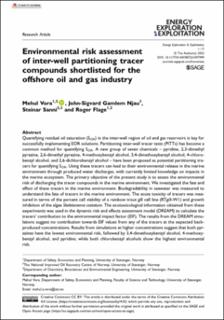| dc.contributor.author | Vora, Mehul Arun | |
| dc.contributor.author | Njau, John-Sigvard Gamlem | |
| dc.contributor.author | Sanni, Steinar | |
| dc.contributor.author | Flage, Roger | |
| dc.date.accessioned | 2022-07-13T13:20:08Z | |
| dc.date.available | 2022-07-13T13:20:08Z | |
| dc.date.created | 2022-05-26T22:51:43Z | |
| dc.date.issued | 2022-05 | |
| dc.identifier.citation | Vora, M., Njau, J-S.G., Sanni, S. & Flage, R. (2022) Environmental risk assessment of inter-well partitioning tracer compounds shortlisted for the offshore oil and gas industry. Energy Exploration & Exploitation | en_US |
| dc.identifier.issn | 0144-5987 | |
| dc.identifier.uri | https://hdl.handle.net/11250/3005089 | |
| dc.description.abstract | Quantifying residual oil saturation (SOR) in the inter-well region of oil and gas reservoirs is key for successfully implementing EOR solutions. Partitioning inter-well tracer tests (PITTs) has become a common method for quantifying SOR. A new group of seven chemicals – pyridine, 2,3-dimethyl pyrazine, 2,6-dimethyl pyrazine, 4-methoxybenzyl alcohol, 3,4-dimethoxybenzyl alcohol, 4-chlorobenzyl alcohol, and 2,6-dichlorobenzyl alcohol – have been proposed as potential partitioning tracers for quantifying SOR. Using these tracers can lead to their environmental release in the marine environment through produced water discharges, with currently limited knowledge on impacts in the marine ecosystem. The primary objective of the present study is to assess the environmental risk of discharging the tracer compounds in the marine environment. We investigated the fate and effect of these tracers in the marine environment. Biodegradability in seawater was measured to understand the fate of tracers in the marine environment. The acute toxicity of tracers was measured in terms of the percent cell viability of a rainbow trout gill cell line (RTgill-W1) and growth inhibition of the algae Skeletonema costatum. The ecotoxicological information obtained from these experiments was used in the dynamic risk and effects assessment model (DREAM) to calculate the tracers’ contribution to the environmental impact factor (EIF). The results from the DREAM simulations suggest no contribution towards EIF values from any of the tracers at the expected back-produced concentrations. Results from simulations at higher concentrations suggest that both pyrazines have the lowest environmental risk, followed by 3,4-dimethoxybenzyl alcohol, 4-methoxybenzyl alcohol, and pyridine; while both chlorobenzyl alcohols show the highest environmental risk. | en_US |
| dc.language.iso | eng | en_US |
| dc.publisher | SAGE Publishing | en_US |
| dc.rights | Navngivelse 4.0 Internasjonal | * |
| dc.rights.uri | http://creativecommons.org/licenses/by/4.0/deed.no | * |
| dc.subject | petroleumsteknologi | en_US |
| dc.subject | miljørisiko | en_US |
| dc.subject | olje- og gassnæringen | en_US |
| dc.subject | biodegradability | en_US |
| dc.subject | toxicity | en_US |
| dc.title | Environmental risk assessment of inter-well partitioning tracer compounds shortlisted for the offshore oil and gas industry | en_US |
| dc.type | Peer reviewed | en_US |
| dc.type | Journal article | en_US |
| dc.description.version | publishedVersion | en_US |
| dc.rights.holder | © The Author(s) 2022 | en_US |
| dc.subject.nsi | VDP::Teknologi: 500::Berg‑ og petroleumsfag: 510 | en_US |
| dc.source.journal | Energy exploration & exploitation | en_US |
| dc.identifier.doi | 10.1177/01445987221097999 | |
| dc.identifier.cristin | 2027622 | |
| cristin.ispublished | true | |
| cristin.fulltext | original | |
| cristin.qualitycode | 1 | |

